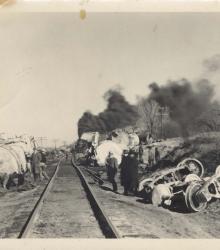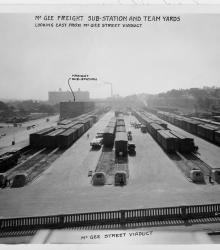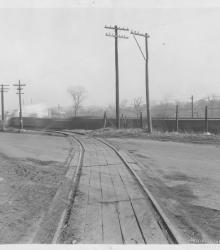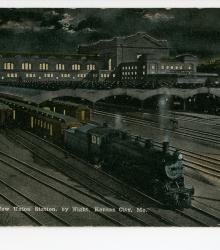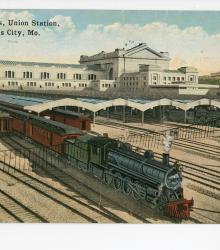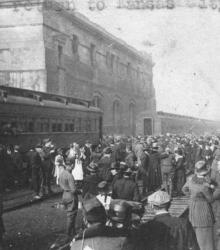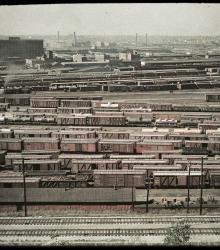Photograph of activity centered on railroad tracks, circa 1920s. A train is in operation at the background of the image, with tracks running to the foreground. Men stand on either side of the tracks, alongside large tanks on the left and train wheels on the right.
Railroad trains
Photograph looking east towards the McGee freight sub-station and team yards from the McGee Street Viaduct.
Circa 1925 photograph looking east at the intersection of Independence Road (presently Wilson Avenue) and Wheeling Avenue. Pictured is a train on the Kansas City Terminal Railway.
A lithograph on paper by Thomas Hart Benton depicting an adult and child waving to a passing train at the edge of a stark Midwestern town. This representational print was created while Benton taught at the Kansas City Art Institute. The original dimensions are 9 x 10 3/4 in. (22.7 x 27.5 cm).
Postcard showing Kansas City Union Station and its train sheds to the west. This vantage point faces southeast towards Union Station from near the defunct intersection of Broadway Boulevard and Milwaukee Avenue (now 22nd Street). The back of the postcard includes a short letter to W. B. Walker of Okmulgee, Oklahoma.
Postcard showing the Kansas City Union Station and its train sheds to the west. This vantage point faces southeast towards Union Station from near the defunct intersection of Broadway Boulevard and Milwaukee Avenue (now 22nd Street). The back of the postcard includes a short letter to Mrs. Harley McCasland of Jefferson City, Missouri.
Returning to Kansas City for reception and parade after World War I. From an album of Lorain H. Cunningham, who served in the 129th Field Artillery during World War I and was a friend of Harry S. Truman. The photo was titled, "Our return to Kansas City".
An autochrome photograph of the West Bottoms and Kansas City Stock Yards as seen looking west from Kersey Coates Drive at its intersection with Beardsley Road, just north of 17th Street. This vantage point shows the St.
